Phase 4: Build a Distributed Key-Value Store
In Phase 4 of your class, you will implement a distributed Key-Value Store that runs on multiple nodes on Amazon EC2 and uses Two-Phase Commit for atomic operations, replication for performance and fault-tolerance, and encryption for security. As in previous phases, you will submit an initial design document and a final design document apart from the code itself.
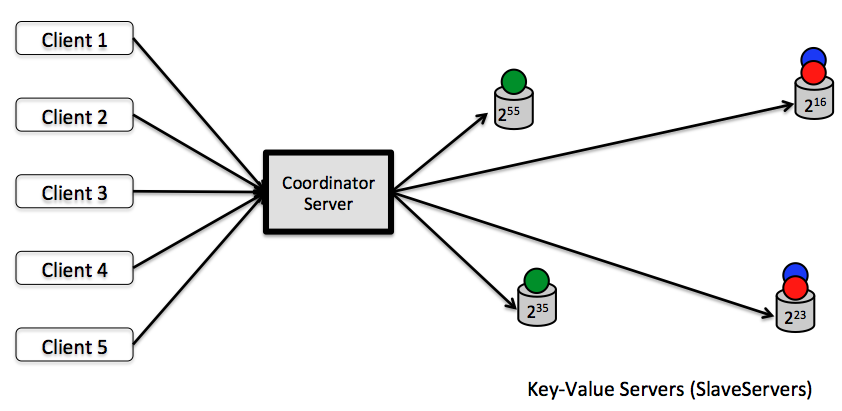
Figure: A distributed Key-Value Store with replication factor of two.
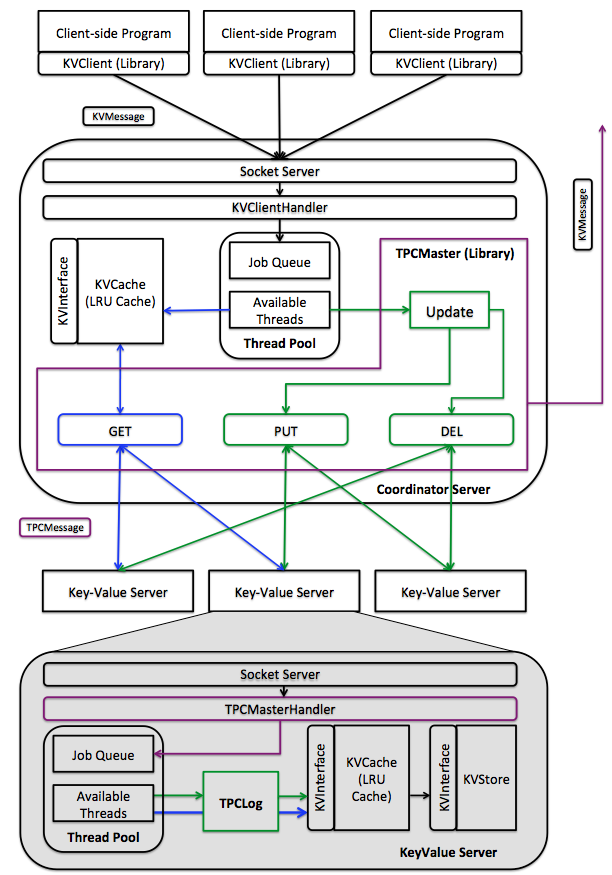
Figure: Functional digram of a distributed key-value store. Components in colors other than black are the key ones you will be developing for this project. Blue depicts GET execution path, while green depicts PUT and DEL; purple ones are shard between operations. Components in black might also require minor modifications to suite your purposes.
Skeleton Code:
The project skeleton you should build on top of is posted at https://github.com/CS162Berkeley/Project4Skeleton. If you have git installed on your system, you can run git clone https://github.com/CS162Berkeley/Project4Skeleton.git, or else you can download the tarball from here. Phase 4 builds on top of the Single Server Key-Value Store developed in Phase 3; however, several interfaces have been extended to support the required functionalities for Phase 4. You can reuse the code developed for Phase 3 and define additional classes and methods as you deem fit.
EC2 instructions:
Read the instructions carefully from this document regarding instantiation, operation, and termination of EC2 instances. As always, let us know in Piazza if anything is unclear.
Requirements:
- Unless otherwise specified below, you will have to satisfy the requirements described in Phase 3.
- Each Key will be stored using 2PC to two Key-Value servers; the first of them will be selected using consistent hashing, while the second will be placed in the successor of the first one. There will be at least two Key-Value servers in the system. See below for further details.
- Key-value servers will have 64-bit globally unique IDs (use unique long numbers), and they will register with the coordinator with that ID when they start. For simplicity, you can assume that the total number of Key-Value servers are fixed, and they always come back with the same ID if they crash. Note that this simplification will cause the system to block on any failed Key-Value server. However, not assuming this will require dynamic successor adjustment and re-replication, among other changes.
- You do not have to support concurrent update operations irrespective of which Key they are working on (i.e., 2PC PUT and DELETE operations are performed one after another), but retrieval operations (i.e., GET) of different Keys must be concurrent unless restricted by an ongoing update operation on the same Key.
- Coordinator communication to individual replicas must be performed in parallel, i.e., requests for vote and dissemination of global decisions must be performed using multiple threads.
- For this particular project, you can assume that the Coordinator will not crash. Consequently, there is no need to log its states, nor does it require to survive failures. Individual Key-Value servers, however, must log necessary information to survive from failures.
- The coordinator server will include a write-through LRU cache, which will have the same semantics as the write-through cache you used before. Caches at Key-Value servers will still remain write-through.
- You should bulletproof your code, such that the no server crashes under any circumstances.
- For your final submission, you will submit your code using the same command as before. The very first section of your final design document must include how exactly to run your submitted code.
- You will run the client interface of the Coordinator service on port 8080.
- Individual Key-Value servers must use random ports assigned upon creating respective SocketServers for listening to 2PC requests and register themselves with the 2PC interface of the Coordinator service running on port 9090.
Tasks (weight / approximate lines of code):
- (40% / 250 loc) Implement the 2PCMaster class that implements 2PC coordination logic in the Coordinator server. 2PCMaster must select replica locations using consistent hashing.
- (35% / 220 loc) Implement the 2PCMasterHandler class that implements logic for 2PC participants in Key-Value servers.
- (10% / 75 loc) Implement registration logic in SlaveServer (aka Key-Value Server) and RegistrationHandler in 2PCMaster. Each SlaveServer has a unique ID that it uses to register with the 2PCMaster in the coordinator.
- (10% / 75 loc) Implement the 2PCLog class that Key-Value servers will use to log their states during 2PC operations and for rebuilding during recovery.
- (5% / 40 loc) Implement encryption/decryption of stored values. The first message to be exchanged between client and server has to be an encryption key. Add a new message type "getEnKey" to the existing message types. The server has a single encryption key generated when it starts and shares this key with clients when requested using "getEnKey".You can store the values in encrypted format at server end.
Consistent Hashing
As mentioned earlier, Key-Value servers will have unique 64-bit IDs. The coordinator will hash the Keys to 64-bit address space. Then each Key-Value server will store the first copies of Keys with hash values greater than the ID of its immediate predecessor up to its own ID. Note that, each Key-Value server will also store the Keys whose first copies are stored in its predecessor.
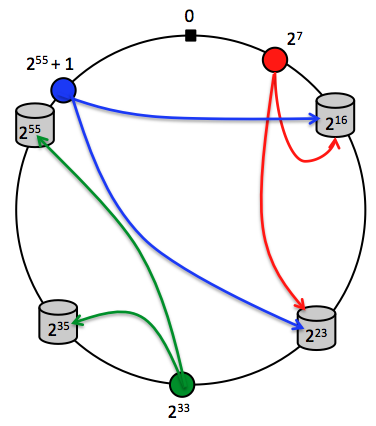
Figure: Consistent Hashing. Four Key-Value servers and three hashed Keys along with where they are placed in the 64-bit address space.
Sequence of Operations During Concurrent GET and PUT (DELETE) Requests
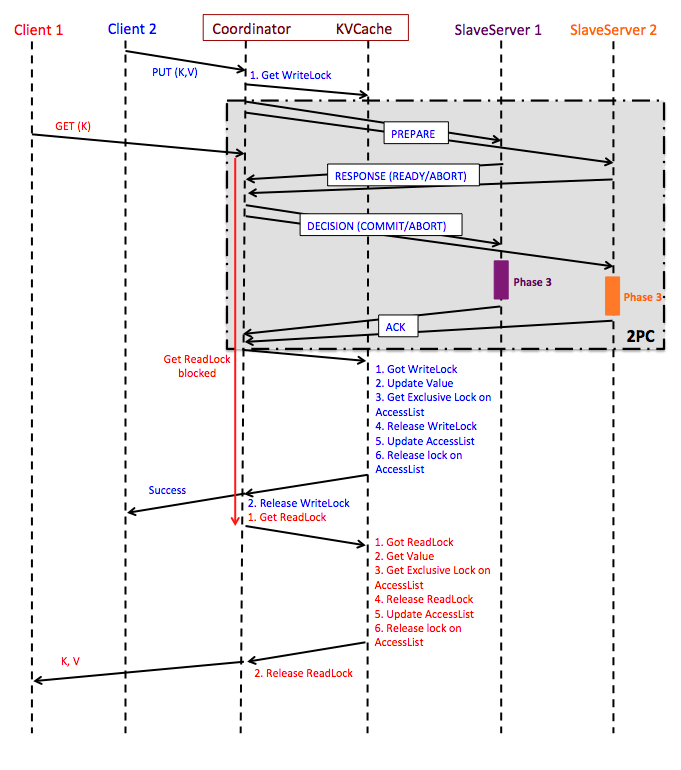
Figure: Sequence diagram of concurrent Read/Write operations in Phase 4. "Phase 3" blocks in the digram refer to the sequence diagram of activities when clients write to a single-node Key-Value server, where the Coordinator is the client to individual Key-Value servers. GET request from Client 1 is hitting the cache in the above diagram; if it had not, the GET request would have been forwarded to each of the SlaveServers until it is found.
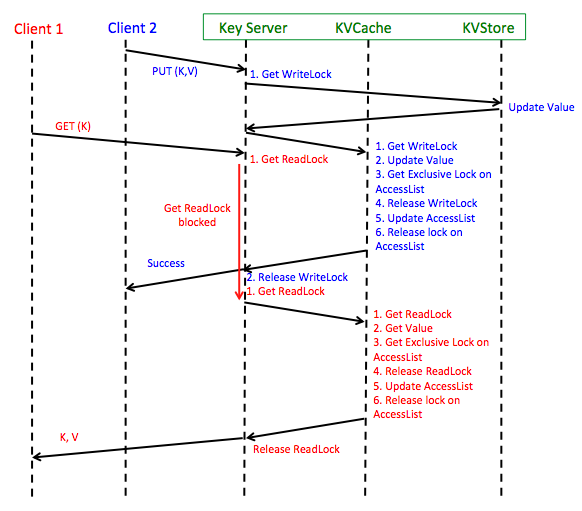
Figure: Sequence diagram of concurrent Read/Write operations in Phase 3.
Your Key-Value server should support the GET/PUT/DELETE interface using the same format as Phase 3 with the following change(s):
- Multiple error messages in case of an abort should be placed in the same Message field of a "resp" message prefixed by "@SlaveServerID=>" and separated by the newline character ('\n'). Example:
<?xml version="1.0" encoding="UTF-8"?>
<KVMessage type="resp">
<Message>@SlaveServerID1=>ErrorMessage1\n@SlaveServerID2=>ErrorMessage2</Message>
</KVMessage>
Your Coordinator Server should perform Two-Phase Commit using the following extended KVMessage format (2PCMessage piggybacked on KVMessage):
- 2PC Put Value Request:
<?xml version="1.0" encoding="UTF-8"?>
<KVMessage type="putreq">
<Key>key</Key>
<Value>value</Value>
<TPCOpId>2PC Operation ID</TPCOpId>
</KVMessage>
- 2PC Delete Value Request:
<?xml version="1.0" encoding="UTF-8"?>
<KVMessage type="delreq">
<Key>key</Key>
<TPCOpId>2PC Operation ID</TPCOpId>
</KVMessage>
- 2PC Response - READY:
<?xml version="1.0" encoding="UTF-8"?>
<KVMessage type="ready">
<TPCOpId>2PC Operation ID</TPCOpId>
</KVMessage>
- 2PC Response - ABORT:
<?xml version="1.0" encoding="UTF-8"?>
<KVMessage type="abort">
<Message>Error Message</Message>
<TPCOpId>2PC Operation ID</TPCOpId>
</KVMessage>
- 2PC Decision - COMMIT:
<?xml version="1.0" encoding="UTF-8"?>
<KVMessage type="commit">
<TPCOpId>2PC Operation ID</TPCOpId>
</KVMessage>
- 2PC Decision - ABORT:
<?xml version="1.0" encoding="UTF-8"?>
<KVMessage type="abort">
<TPCOpId>2PC Operation ID</TPCOpId>
</KVMessage>
- 2PC Acknowledgement:
<?xml version="1.0" encoding="UTF-8"?>
<KVMessage type="ack">
<TPCOpId>2PC Operation ID</TPCOpId>
</KVMessage>
Registration Messages
- Register:
<?xml version="1.0" encoding="UTF-8"?>
<KVMessage type="register">
<Message>SlaveServerID@HostName:Port</Message>
</KVMessage>
- Registration ACK:
<?xml version="1.0" encoding="UTF-8"?>
<KVMessage type="resp">
<Message>Successfully registered SlaveServerID@HostName:Port</Message>
</KVMessage>
TPCLog Entries
- READY for PUT
<?xml version="1.0" encoding="UTF-8"?>
<KVMessage type="ready">
<Key>key</Key>
<Value>value</Value>
<Message>putreq</Message>
<TPCOpId>2PC Operation ID</TPCOpId>
</KVMessage>
- READY for DEL
<?xml version="1.0" encoding="UTF-8"?>
<KVMessage type="ready">
<Key>key</Key>
<Message>delreq</Message>
<TPCOpId>2PC Operation ID</TPCOpId>
</KVMessage>
- ABORT
<?xml version="1.0" encoding="UTF-8"?>
<KVMessage type="abort">
<TPCOpId>2PC Operation ID</TPCOpId>
</KVMessage>
- COMMIT
<?xml version="1.0" encoding="UTF-8"?>
<KVMessage type="commit">
<TPCOpId>2PC Operation ID</TPCOpId>
</KVMessage>
Encryption Messages
- Encryption Key request
<?xml version="1.0" encoding="UTF-8"?>
<KVMessage type="getEnKey">
</KVMessage>
- Server response
<?xml version="1.0" encoding="UTF-8"?>
<KVMessage type="resp">
<Message>Encryption Key</Message>
</KVMessage>
Testing/Debugging Messages
- Ignore next PUT or DEL request
On reception of this message from a Client, KVClientHandler in the Master/Coordinator will forward the message to the specific SlaveServer. The SlaveServer will abort the immediate next PUT or DEL request in the first phase that 2PC operation. This message is valid for only the next PUT or DEL request. The SlaveServer will go back to normal operation after aborting one 2PC operation.
<?xml version="1.0" encoding="UTF-8"?>
<KVMessage type="ignoreNext">
<Message>SlaveServerID</Message>
</KVMessage>
SlaveServer will acknowledge the successful reception using the following message:
<?xml version="1.0" encoding="UTF-8"?>
<KVMessage type="resp">
<Message>Success</Message>
</KVMessage>
Error messages in addition to the ones in Phase 3:
- "Registration Error: Received unparseable slave information" -- Registration information was not in "slaveID@hostName:port" format.
- "Timeout Error: SlaveServer <slaveID> has timed out during the first phase of 2PC" -- Obviously, replace <slaveID> with the ID of the SlaveServer.
- "IgnoreNext Error: SlaveServer <slaveID> has ignored this 2PC request during the first phase"
Concepts you are expected to learn
- Two-Phase Commit
- Encryption
- Logging and Recovery using Logs
- Consistent Hashing
- Failure Detection using Timeouts




